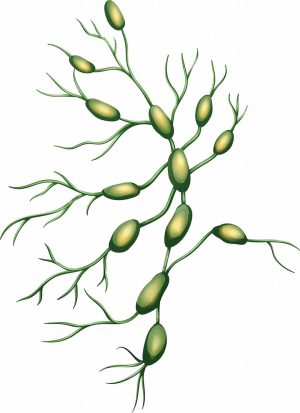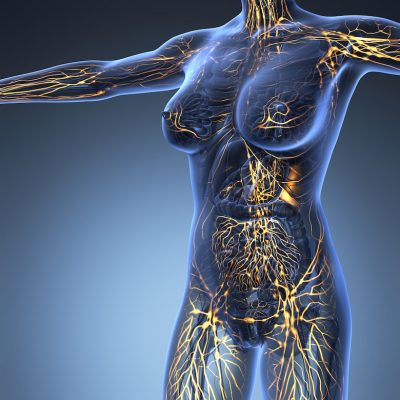Anatomy & Physiology of the Lymphatic System
Lymphatic System Formation
The lymphatic system develops about 2 weeks after the cardiovascular system in the 5th week of pregnancy. You can read in-depth on lymphatic embryologic development here.
Lymphatic System Function
To recap the basic functions of the lymphatic system that were discussed in “What the Heck is Lymph,” the body uses the lymphatic system to transport fluid from between the cells back into the circulatory system.
This lymphatic fluid carries with it fat, proteins, waste products from cell metabolism, and other large molecules.
The lymphatic system is also a part of the immune system and houses white blood cells (lymphocytes). It also filters out foreign bodies such as bacteria, toxins, and cancer cells by trapping them in the lymph nodes.
Lymph Nodes
The lymph nodes are where these intruders are broken down into harmless components.
Lymph nodes (filters) exist throughout the body, but are most commonly found at places where the body bends. Examples would be the armpits (axilla), elbows, hip crease (inguinal area), the knees, and the neck (cervical area). Lymph nodes also exist in abundance in and around the small and large intestine.

The cervical lymph nodes in the neck are commonly (and incorrectly) called “glands.” When we are sick or are fighting an infection, the lymph nodes are often swollen and sore because they are busy breaking down the harmful substances (viruses, bacteria, etc.) to which we have been exposed.
When your doctor feels for your lymph nodes in your neck if you come in complaining of being sick, he or she is checking to see if they are full of invading pathogens (bacteria, viruses, etc.).
Other important parts of the lymphatic system are the spleen, the thymus gland, the tonsils, and Peyer’s Patches.
Lymphatic Pathways
Approximately 70% of our lymph is found just under the skin in the lymphatic capillaries and collectors which are similar to veins, but they carry lymph instead of blood.
Superficial lymph in the arms and legs drain to the regional lymph nodes found in the axilla (underarms) and inguinal area (hip crease).
Lymph coming from the inguinal lymph nodes in the hips and the left axilla (underarm) flows towards the center of the abdomen just below the diaphragm.
Here the lymph is collected collected in an enlarged lymphatic pathway called the Cisterna Chyli. From there the lymph travels up towards the top of the breastbone through a large vessel called the Thoracic Duct. Once at the top of the Thoracic Duct, the lymph drains into the circulatory system at the left Subclavian (under the collarbone) Vein which connects directly to the heart.
The right upper side of the body takes a slightly different route. Instead of going to the Cisterna Chyli, it heads straight up to the right collar bone and dumps into the circulatory system at the right Subclavian Vein at the Right Lymphatic Duct.

Lymphatics of the Brain
In 2015 researchers located and documented the lymphatic vessels in the brain. Up until that point, it was believed by present day scientists that there were no lymphatics in the brain or Central Nervous System. Ironically, research done in the 1960’s and 1990’s that proved their existence was ignored. So, in fact, it was a “re-discovery.”

This finding was significant because it led to the discovery that the lymphatics are how the brain drains out the proteins and plaques that lead to Alzheimer’s and Parkinson’s diseases in rodent models.
Rate of Lymphatic Flow
In a healthy individual, the rate at which lymph flows from the body’s tissues (interstitium – meaning, “between the cells”) back to the circulatory system is determined by how much fluid exists in the area between the cells. If there is a lot of fluid between the cells (swelling), then the rate of lymphatic flow will be high to remove that fluid and return it to circulation.
However, in people with a compromised or congested lymphatic system, the rate of flow is slowed down. Compromised lymphatics can be caused by injury, surgery, or genetic conditions which cause the lymphatic system to not develop properly. Congested lymphatics can be caused by dehydration, exposure to toxins, tight fitting clothing, and being sedentary.
Another factor that affects the rate of lymphatic flow is the amount of swelling in an area. In very edatamous (swollen) areas, the lymph vessels (“highways”) are compressed like a flattened hose with bricks on top of it, and lymph cannot enter the vessels in order to leave the swollen areas.
Movement Is Key to Good
Lymphatic Flow
The amount of activity of the body also impacts the rate of flow. A person who is sedentary is more likely to have swelling because movement of the body helps to propel lymph along its pathway back to the circulatory system.
Movement of any kind can help to move lymph. Deep breathing and the pulsation of the circulatory system due to the beating of the heart cause lymph to be propelled through the lymphatic system. Even movement of an arm or leg by a therapist (called “passive movement”) can assist in lymphatic drainage.
Mild, external compression helps to move lymph.
To help increase lymphatic flow, Manual Lymphatic Drainage (MLD) and Electro-Lymphatic Therapy work to get the Thoracic Duct to empty into the circulatory system. When it is empty, the Thoracic Duct acts like a vacuum and pulls lymph from other areas of the body.

Make an Appointment to Move Your Lymph
Whether you go for a swim, a hike, or just get out and walk around the block, your lymphatic system will thank you.




